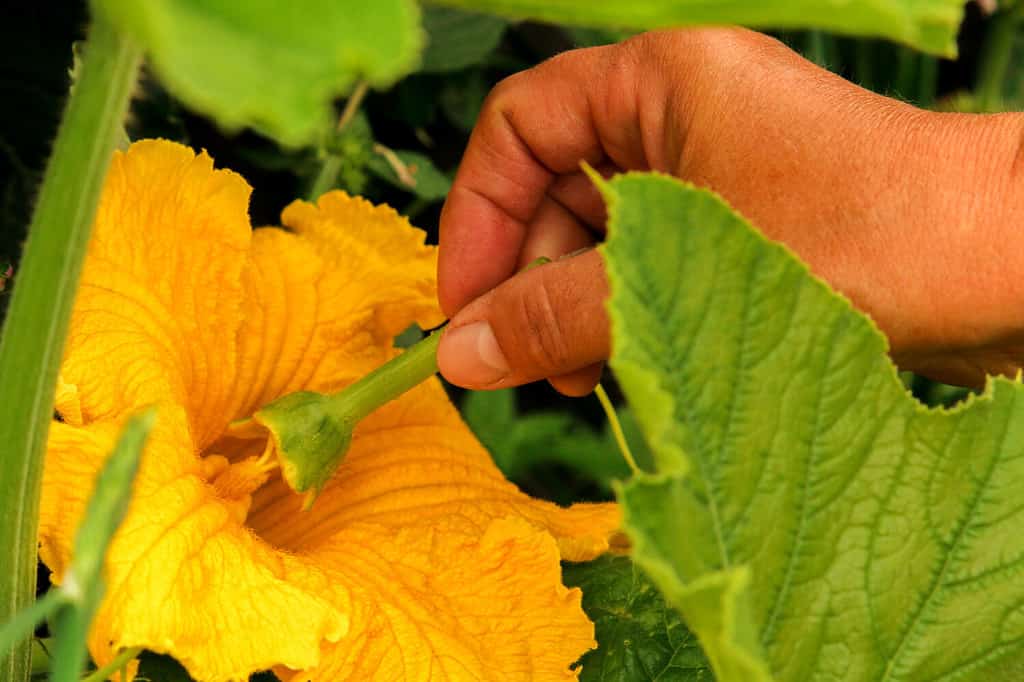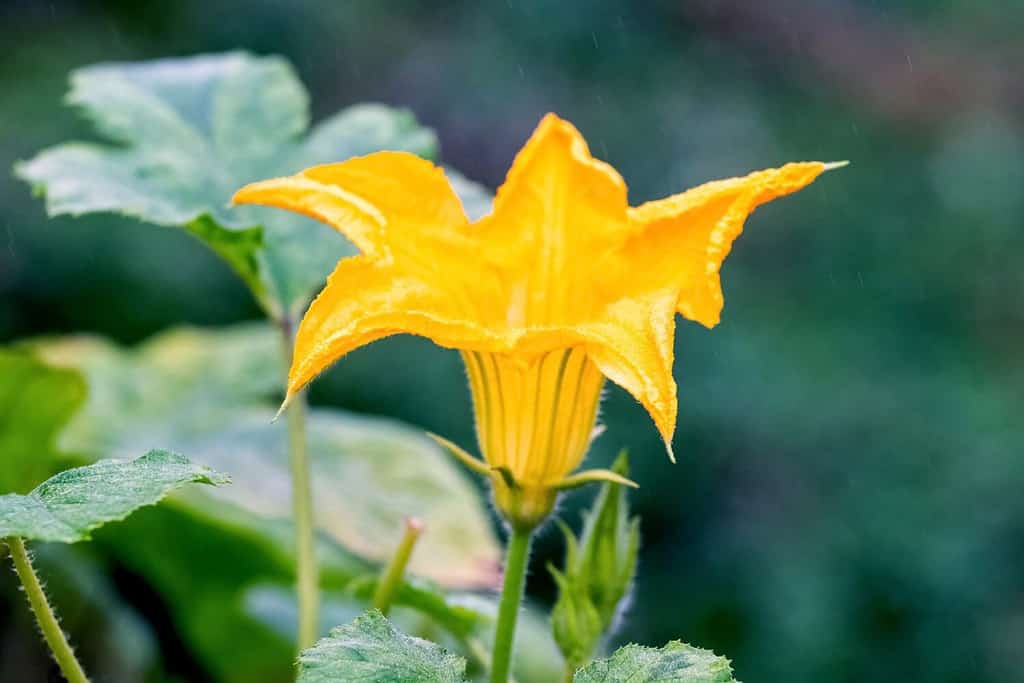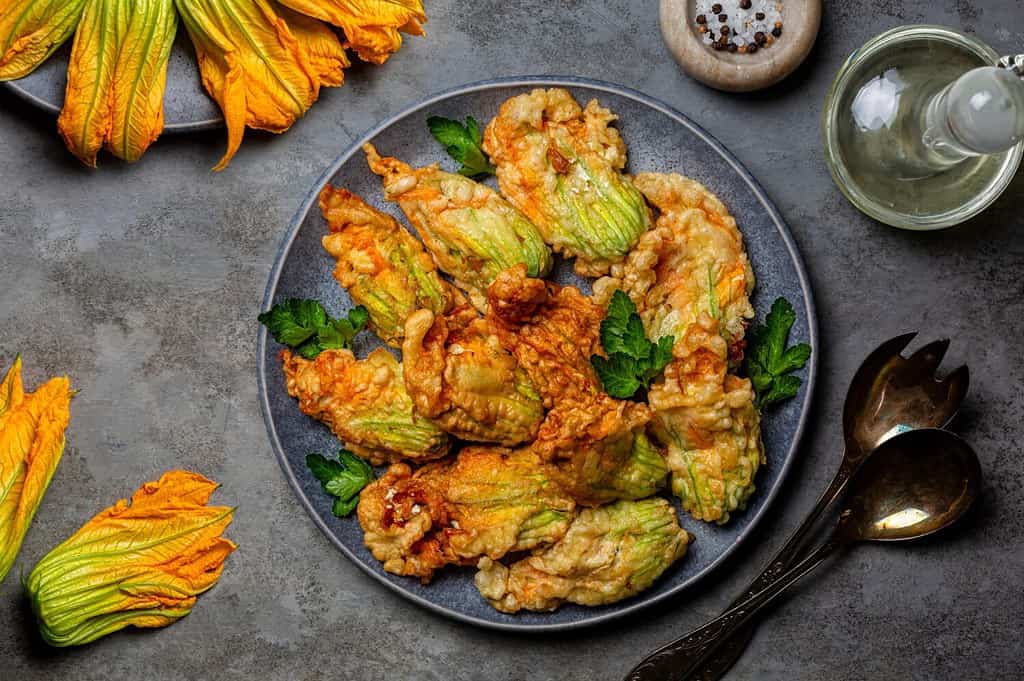Did you know squashes have female and male flowers? At first glance, it might seem like all squash flowers wear the same sunny yellow hues. But look closer, and you’ll discover the fascinating divide between the sexes. In this article, we’ll break down the key differences between male vs. female squash flowers and their purpose for the plant’s longevity.
What Purpose Do Squash Flowers Serve?
Squash flowers play a vital role in both the natural world and agriculture. These blossoms, which grace various types of squash plants, are far more than mere adornments. They serve essential functions, contributing to the plant’s reproductive success and even culinary delights. Understanding the purpose of squash flowers sheds light on their significance in our ecosystem and on our plates.
Reproduction and Pollination
At their core, squash flowers are nature’s matchmakers, facilitating the reproduction of squash plants. They are divided into two types: male and female. Male flowers, identifiable by their slender stems and distinct anthers, produce pollen. In contrast, female flowers possess a miniature fruit at their base, the ovary, and a stigma ready to receive pollen. The union of pollen from male to female flowers is crucial for fruit formation, ensuring the next generation of squash plants.
The Role of Pollinators
To accomplish this critical task, squash flowers rely on pollinators such as bees, butterflies, and even wind. Bees, in particular, are frequent visitors to squash blooms, collecting nectar while inadvertently transferring pollen between flowers. This intricate dance of pollination is essential for the production of healthy, bountiful squash crops. Without pollinators, the chances of fruit development diminish significantly, highlighting the pivotal role of squash flowers in agriculture.
Attracting Pollinators
Squash flowers have evolved to attract pollinators through their striking appearance and enticing fragrance. Their vibrant colors, typically shades of yellow and orange, serve as visual beacons, guiding insects to their nectar-rich centers. Additionally, the sweet aroma emitted by the flowers acts as a natural lure, drawing pollinators from afar. In this way, squash flowers actively engage in a mutually beneficial relationship with their pollinator partners.
Culinary Delights
Beyond their role in reproduction, squash flowers offer culinary pleasures for humans. These delicate blossoms are edible and are a popular ingredient in various cuisines worldwide. Both male and female flowers are used in cooking, each offering a unique flavor and texture. Male flowers are often preferred for their milder taste, while female flowers can contain a young, tender squash attached. From stuffed squash blossoms to fritters, these edible flowers add a touch of elegance and flavor to dishes. We’ll take a look at some more dishes later on in this guide, as well as when you should use male vs. female squash flowers for certain recipes.
Cultural Significance
In addition to their biological and culinary roles, squash flowers hold cultural significance in various societies. They are symbols of fertility and abundance in some cultures and are incorporated into rituals and celebrations. Their presence in traditional dishes reflects a connection between people and the land, honoring the natural world’s generosity.
Conservation and Biodiversity
Squash flowers, as key players in the pollination process, also contribute to biodiversity and ecosystem health. Their role in the reproduction of squash plants extends to other plant species in their vicinity. This interdependence ensures a thriving ecosystem, with diverse flora and fauna benefiting from the services of pollinators attracted to squash flowers. Preserving these flowers and their pollinator interactions is essential for maintaining biodiversity.

Squash flowers like the zucchini flower (pictured) can grow to be quite large.
©masterpiece creator/Shutterstock.com
The Differences Between Male vs. Female Squash Flowers
In the world of squash plants, understanding the differences between male and female flowers is a valuable skill for any gardener. These distinctions play a vital role in the plant’s reproductive process and, consequently, the yield of your squash crop.
The Role of Male and Female Flowers
Male and female squash flowers are not just ornamental; they are essential components of the squash plant’s reproductive system. These blossoms differ in their anatomy and function, working together to ensure the plant’s survival and fruit production.
Male Flowers
Male squash flowers, often the first to appear on the plant, serve as pollen producers. They are typically more numerous than their female counterparts and play a pivotal role in the pollination process. Male flowers have a slender, straight stem that extends from the main vine. At the tip of this stem, you’ll find the characteristic golden-yellow petals, forming a star-like shape. In the center of the petals, there’s a prominent stamen with a single anther, the part responsible for producing pollen.
Female Flowers
Female squash flowers, on the other hand, are easily identified by their distinct features related to fruit development. They appear slightly later in the growing season and have a tiny embryonic fruit or baby squash attached at the base of the blossom. Female flowers have shorter stems, which are often curved or crooked. The petals are also yellow, resembling those of the male flowers, but they are usually larger and more vibrant. In the center of the petals, you’ll find a stigma, which is a feathery structure designed to capture pollen, leading to fertilization and fruit formation.
How to Identify Male Squash Flowers
Identifying male squash flowers is relatively straightforward once you know what to look for. Here are the key characteristics that distinguish male flowers:
- Slim Stem: Male flowers have a thin, straight stem that extends from the main vine.
- Golden-Yellow Petals: Male flowers feature bright yellow petals that form a star-like shape.
- Prominent Stamen: In the center of the petals, you’ll see a conspicuous stamen with a single anther. This anther contains the pollen.
- Absence of a Baby Squash: Male flowers lack the miniature squash at their base, as they are solely dedicated to pollen production.
How to Identify Female Squash Flowers
Female squash flowers are equally easy to recognize with their distinct characteristics:
- Shorter, Curved Stem: Female flowers have a shorter stem that may be slightly curved or crooked.
- Yellow Petals: Like male flowers, female blossoms also have yellow petals, but they are often larger and more vibrant.
- Tiny Embryonic Fruit: At the base of the female flower, you’ll notice a small, undeveloped squash. This is a telltale sign of a female blossom, as it indicates the potential for fruit production.
- Stigma at the Center: In the middle of the petals, you’ll find a stigma, which is a feathery structure designed to capture pollen during pollination.
Why Identifying Male and Female Flowers Matters
Knowing how to distinguish male and female squash flowers is not merely a matter of curiosity; it has practical implications for your squash harvest. Successful pollination relies on the presence of both types of flowers, as it’s the transfer of pollen from the male to the female flowers that initiates fruit development.
Without proper pollination, your squash plants may produce fewer fruits or even fail to set fruit altogether. This can be frustrating for gardeners, as the absence of squash blossoms turning into mature fruits can be disheartening. By recognizing and encouraging the presence of both male and female flowers, you can enhance your chances of a bountiful harvest.
Encouraging Pollination
To ensure effective pollination and a healthy squash crop, consider the following tips:
- Attract Pollinators: Bees and other pollinators play a crucial role in transferring pollen between squash flowers. To attract them, plant flowers and herbs nearby or provide a source of clean water.
- Avoid Pesticides: Pesticides can harm pollinators. Whenever possible, use organic pest control methods to protect your plants.
- Hand Pollination: If you notice a lack of pollinators in your area, consider hand-pollinating your squash flowers. Gently transfer pollen from the male to the female flowers using a small brush or your fingertip.
When it comes down to it, understanding the differences between male and female squash flowers is a valuable skill for any gardener. These distinctions are not only fascinating but also essential for the successful pollination and fruit production of your squash plants.

There are several differences between male vs. female squash flowers.
©MVolodymyr/Shutterstock.com
How to Get More Female Squash Flowers on Your Plant
If you’re an avid gardener or simply someone who enjoys a beautiful and productive garden, you may be wondering how to get more flowers on your squash plants. Fortunately, there are several key strategies you can employ to encourage your squash plants to produce more flowers.
Choose the Right Location
First and foremost, ensure that your squash plants are located in an ideal spot. Squash plants do best in full sun, so make sure they can get at least six hours of straight sunlight each day. Proper sunlight is crucial for all plants to go through photosynthesis, a process that provides the energy needed for flower and fruit production.
Proper Soil Preparation
Preparing the soil is another critical step in promoting flower production. Squash plants prefer well-draining soil with compost. This nutrient-rich environment will encourage healthy flower development.
Adequate Watering
Consistent and adequate watering is essential for squash plants. Irregular watering can lead to stress, which can hinder flower production. Keep the soil consistently moist but not waterlogged. Water at the base of the plant to avoid wetting the foliage, as wet leaves can be susceptible to diseases.
Fertilize Wisely
Squash plants are heavy feeders, so providing the right nutrients is crucial for flower production. Use a balanced fertilizer with a 1:1:1 ratio of nitrogen, phosphorus, and potassium. Keep in mind that over-fertilization can lead to excessive foliage growth at the expense of flowers, so be cautious not to overdo it.
Pruning and Maintenance
Regular maintenance, including pruning, can help promote more flowers on your squash plants. Prune away any dead or diseased leaves to improve air circulation and reduce the risk of fungal infections. Additionally, removing excessive foliage can redirect the plant’s energy toward flower and fruit production.
Pollination Assistance
Squash plants rely on pollinators, like bees, for successful flower pollination. To ensure pollinators can access your squash flowers easily, avoid using pesticides that may harm them. You can also hand-pollinate your squash if you notice a lack of pollinators in your area. To do this, gently transfer pollen from male flowers to female flowers using a small brush or your fingertip.
Companion Planting
Consider companion planting to attract more pollinators to your garden. Flowers like marigolds and zinnias can help attract beneficial insects that will aid in the pollination of your squash plants. Plant these flowers near your squash to create a pollinator-friendly environment.
Monitor for Pests and Diseases
Keep a watchful eye on your squash plants for any signs of pests or diseases. Aphids, squash bugs, and powdery mildew are common problems that can affect flower production. Address these issues promptly with organic or chemical treatments as needed to keep your plants healthy and thriving.
Harvest Promptly
Once your squash plants begin producing fruit, be sure to harvest them promptly. Leaving overripe or oversized fruit on the plant can signal to the plant that it no longer needs to produce new flowers. Regular harvesting encourages continuous flower production throughout the growing season.

Squash flowers can be used in a wide range of different dishes.
©OlgaBombologna/Shutterstock.com
What to Cook with Squash Flowers
Squash flowers are not just a feast for the eyes and a necessary part of squash reproduction; they are a delectable addition to your culinary repertoire. These male and female edible flowers each lend their unique qualities to various dishes.
Stuffed Squash Blossoms
One of the most popular and visually stunning ways to prepare squash flowers is by stuffing them. Male flowers, with their wide opening and mild taste, are ideal for this purpose. You can stuff them with a variety of fillings, such as cheese, herbs, or seasoned ricotta. Dip them in a light batter and fry until golden brown for a crispy, savory treat that’s sure to impress.
Squash Flower Fritters
Male squash flowers also shine in fritters. Mix a simple batter of flour, water, and seasonings, and gently dip the flowers before frying. The result is a delightful, crispy snack or appetizer that highlights the delicate flavor of the blossoms. These fritters can be enjoyed on their own or as a side dish.
Squash Flower Quesadillas
For a twist on a classic Mexican dish, incorporate squash flowers into quesadillas. Sautéed male flowers can be paired with cheese and other vegetables to create a flavorful filling. The mild taste of the blossoms complements the richness of melted cheese, resulting in a delectable and nutritious meal.
Squash Flower Risotto
Female squash flowers, with their subtle sweetness, can be a delightful addition to a creamy risotto. After sautéing onion and garlic, add Arborio rice and cook until translucent. Then, stir in chopped female squash flowers and continue cooking the risotto with vegetable or chicken broth. Finish with Parmesan cheese and a drizzle of olive oil for a creamy and aromatic dish.
Squash Flower Omelette
Elevate your breakfast or brunch with a squash flower omelet. Whisk eggs and pour them into a hot, buttered skillet. Before the eggs are set, scatter male or female squash flowers and your choice of fillings (such as cheese, herbs, or diced vegetables) over the surface. Fold the omelet and cook until the eggs are just set. This dish showcases the delicate flavor of the blossoms and makes for a delightful start to the day.
Squash Flower Salad
For a lighter option, consider adding squash flowers to your salad. Both male and female flowers can be used to impart a touch of color and flavor to your greens. Their mild taste pairs well with a variety of dressings, and their vibrant appearance adds an elegant touch to your salad bowl.
There are so many things you can cook with squash flowers, and there are so many differences between male vs. female squash flowers. Hopefully, this guide will give you more insight into the reproductive process of squash plants. Happy planting!
The photo featured at the top of this post is © sophiecat/Shutterstock.com
Thank you for reading! Have some feedback for us? Contact the AZ Animals editorial team.







